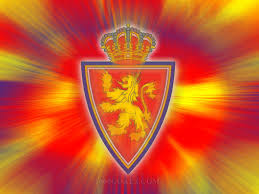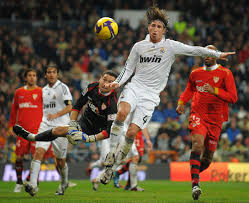

Spanish Primera Division
Spain
The Spanish league, called Liga BBVA this year!
Real Madrid vs Real Zaragoza Official name Real Madrid Club de Fútbol
City Madrid
Founded 1902
Club colors White / White / White
vs.
0 - 0
Real Zaragoza
Official name Real Zaragoza
City Zaragoza
Founded 1932
Club colors White / Blue / White
Match scheduled:
Date: 19-12-2009
Time:21:00 until 23:00
Week 15 / Jornada 15 :: LFP La Liga BBVA 2009/2010 :: BWIN doesn't have the tv rights for Spain, Italy, UK, France and Scandinavia. In Scandanavia Bet365/Betfair have got the rights! / Match also on LaSexta and maybe on CCTV5!

After moving between grounds the team moved to the "Campo de O'Donnell" in 1912, which remained its home ground for eleven years.[5] After this period, the club moved for one year to the Campo de Ciudad Lineal, a small ground with a capacity of 8,000 spectators. After that, Real Madrid moved its home matches to Estadio Chamartín which was inaugurated on 17 May 1923 wi Chujim w dupe h hosted 22,500 spectators, Real Madrid celebrated its first Spanish league title.[7] After some successes, the 1943 elected president Santiago Bernabéu decided that the Estadio Chamartín was not big enough for the ambitions of the club. A new stadium was built and was inaugurated on 14 December 1947.[9][36] This was the Santiago Bernabéu Stadium as it is known today, although it did not acquire this name until 1955.[10] The first match held on Bernabéu was played between Real Madrid and the Portuguese club Belenenses and won by The Whites with 3–1, the first goal being scored by Sabino Barinaga.[9]


Ciudad Real Madrid represents the team training facilities since 2005.
The capacity has changed frequently, peaking at 120,000 after a 1953 expansion.[37][38] Since then, there have been a number of reductions due to modernizations (the last standing places went away in 1998–99 in response to UEFA regulations which forbids standing at matches in the UEFA competition), countered to some extent by expansions.[37] The last change was an increase of about five thousand to a capacity of 80,354, effected in 2003. A plan to add a retractable roof has been announced.[39]
The Bernabéu has hosted the 1964 European Championship final, the 1982 FIFA World Cup final, the 1957, 1969 and 1980 European Cup finals and is due to host the 2010 Champions League Final.[40] The stadium has its own Madrid Metro station along the 10 line called Santiago Bernabéu.[41] On 14 November 2007, the Bernabéu has been upgraded to Elite Football Stadium status by UEFA.[42]
On 9 May 2006, the Alfredo Di Stéfano Stadium was inaugurated at the City of Madrid where Real Madrid usually trains. The inaugural match was played between Real Madrid and Stade Reims, a rematch of the 1956 European Cup final. Real Madrid won the match 6–1 with goals from Sergio Ramos, Cassano (2), Soldado (2), and Jurado. The venue is now part of the Ciudad Real Madrid, the club's new training facilities located outside Madrid in Valdebebas. The stadium holds 5,000 people and is Real Madrid Castilla's home ground. It is named after former Real footballer Alfredo di Stéfano


The progression of Real Madrid's crest since the Club's formation in 1902.
The first crest of Real Madrid had a simple design consisting of a decorative interlacing of the three initials of the club, "MCF" for Madrid Club de Fútbol, in dark blue on a white shirt. The first change in the crest occurred in 1908 when the letters adopted a more streamlined form and appeared inside a circle.[25] The next change in the configuration of the crest did not occur until the presidency of Pedro Parages in 1920. At that time, King Alfonso XIII granted the club his royal patronage which came in the form of the title "Real", roughly translated as "Royal".[26] Thus, Alfonso's crown was added to the crest and the club styled itself Real Madrid Club de Fútbol.[25] With the dissolution of the monarchy in 1931, all the royal symbols (the crown on the crest and the title of Real) were eliminated. The crown was replaced by the dark mulberry band of the Region of Castile.[8] In 1941, two years after the end of the Civil War, the crest's "Real Corona", or "Royal Crown", was restored while the mulberry stripe of Castile was retained as well.[9] In addition, the whole crest was made full color, with gold being the most prominent, and the club was again called Real Madrid Club de Fútbol.[25] The most recent modification to the crest occurred in 2001 when the club wanted to better situate itself for the twenty-first century and further standardize its crest. One of the modifications made was changing the mulberry stripe to a more bluish shade.[25]
| |
| Real Madrid's original kit |
Real Madrid's traditional home colours are all white, although it initially adopted a blue oblique stripe on the shirt (the design was kept in the club crest); but unlike today, dark blue socks were worn.[7][27] The striped shirt was replaced by an all-white version, modeled after the shirt worn by Corinthian F.C., in 1902.[28] In the same year, the blue socks were replaced by black ones. By the early 1940s the manager changed the kit again by adding buttons to the shirt and the club's crest on the left breast (which have remained ever since). On 23 November 1947, in a game against Atlético Madrid at the Metropolitano Stadium, Real Madrid became the first Spanish team to wear numbered shirts.[9]
Real's traditional away colours are all black or all purple. The club's kit is currently manufactured by Adidas whose contract extends from 1998.[29][30] Real Madrid's first shirt sponsor, Zanussi, agreed for the 1982–83, 1983–84 and 1984–85 seasons. Following that, the club was sponsored by Parmalat and Otaysa before a long-term deal was signed with Teka in 1992.[31][32] In 2001, Real Madrid ended their contract with Teka and for one season used the Realmadrid.com logo to promote the club's website. Then, in 2002, a deal was signed with Siemens Mobile and in 2006, the BenQ Siemens logo appeared on the club's shirt.[33] Real Madrid's current shirt sponsor is bwin.com following the economic problems of BenQ Siemens.[34][35] A table showing which company was Real Madrid's kit manufacturer and which company's logo appeared on the face of those shirts as the shirt partner during what time period is shown below (note: first year noted in period column represents the playing season that started in that year, while last year noted represents the end of that year's season. For example, "period 1985-1992" represents seasons '85-'86 through '91-'92).

Real Madrid started when football was introduced to Madrid by the professors and students of the Institución Libre de Enseñanza, which included several Oxbridge graduates. They founded Football Club Sky in 1897, playing on Sunday mornings at Moncloa. It split into two clubs in 1900: New Foot-Ball de Madrid and Club Español de Madrid. The latter club split again in 1902, resulting in the formation of Madrid Football Club on 6 March 1902.[2] Three years after its foundation, in 1905, Madrid FC won its first title after defeating Athletic Bilbao in the Spanish Cup final. The club became one of the founding sides of the Spanish Football Association on 4 January 1909, when club president Adolfo Meléndez signed the foundation agreement of the Spanish FA. After moving between grounds the team moved to the Campo de O'Donnell in 1912.[5] In 1920, the club's name was changed to Real Madrid after King Alfonso XIII granted the title of Real (Royal) to the club.[6]
In 1929, the first Spanish football league was founded. Real Madrid lead the first edition until the last match, a loss to Athletic Bilbao, meant they finished runners-up to Barcelona.[7] Real Madrid won its first League title in the 1931–32 season. The Whites won the League again the following year, becoming the first side to have won the championship twice.[8]
Santiago Bernabéu Yeste became president of Real Madrid in 1945.[9] Under his presidency, the club, the Santiago Bernabéu Stadium and the Ciudad Deportiva were rebuilt following the Spanish Civil War. Beginning in 1953, he embarked upon a strategy of signing world-class players from abroad, the most prominent of them being Alfredo di Stéfano







































